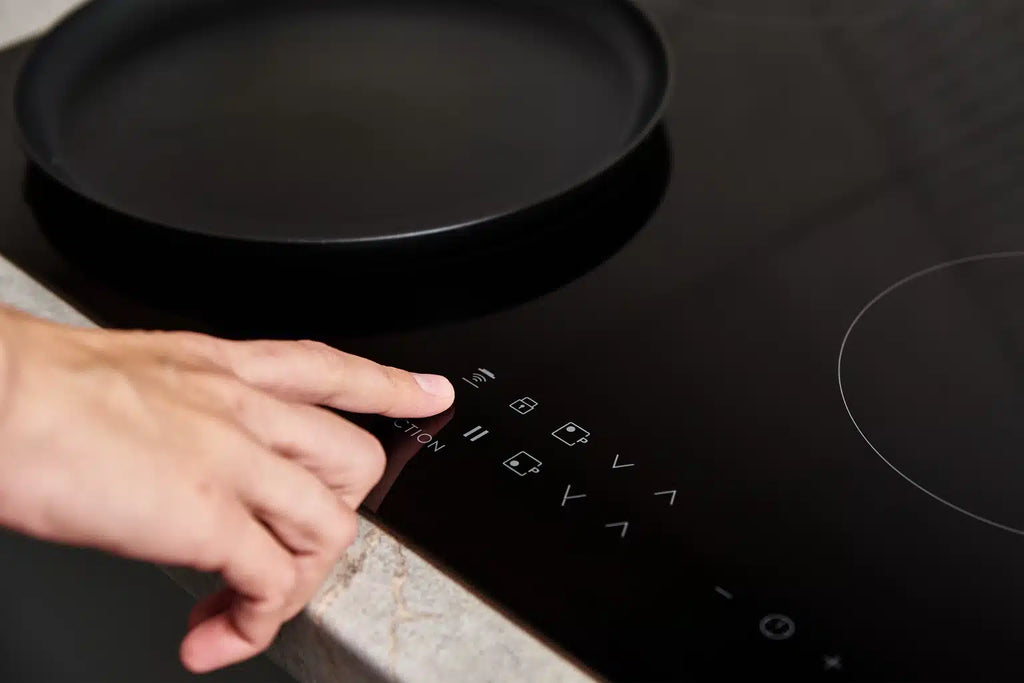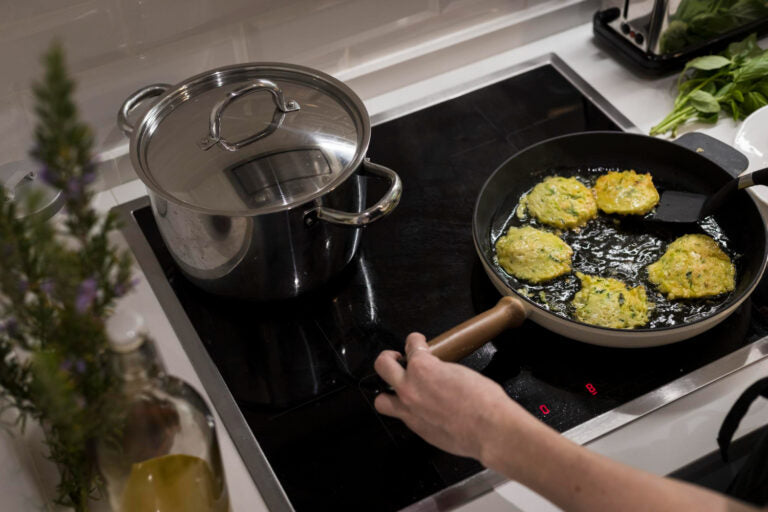Your Cart is Empty
Explore our newest colors - free samples available
Explore our newest colors - free samples available
Explore our newest colors - free samples available
Explore our newest colors - free samples available
March 29, 2024 5 min read

Induction cooktops are the newest energy-efficient cooktops that offer tons of benefits. They convert about 90% of electrical energy into heat with rapid heat-up times. This makes them superior heating devices to gas or electric cooktops. Most experts consider these cooktops a safer alternative to electric and gas cooktops. By not burning gas, these cooktops are super environmentally friendly.
Yes, induction cooktops don't burn gas, so they produce fewer toxic pollutants. You might think this means you don't need a range hood. But not so fast with the clean air analysis! Induction cooktops are indeed safer, but cooking is not a clean process. Cooking still generates excess heat, unpleasant smells, and small airborne food particles. These smells and other particles can be a problem when left to linger. But with fewer pollutants, do you still need a range hood for induction cooking? Let's find out.
Induction cooking is a method that uses electromagnetic fields to heat cookware. This cooking method does not require direct heat transfer from a hot coil or flame. Instead, induction uses electromagnetic energy to focus and generate heat within the cookware. Because induction cooking generates heat in the cookware, this results in faster cooking. By concentrating heat on the cookware, induction cooking reduces energy waste.
Induction cooking uses a scientific principle called electromagnetic induction. The induction cooktop has a glass surface with electromagnetic coils beneath it. The electromagnetic coils under the induction cooktop create a changing magnetic field. When you place a compatible cookware on the cooktop, the magnetic field induces currents within the cookware's base. The resistance of the cookware to these electric currents generates heat inside it.
Induction cooking produces heat within the cookware's base, not on the cooktop surface. The heat generated in the cookware's base moves through the cookware to the food. Simply put, induction cooking converts electricity into heat through magnetism.Only ferromagnetic cookware, like cast iron, carbon steel, or stainless steel, works. Materials like copper, aluminum, and glass will not heat up on an induction cooktop.
There are several types of induction cooktops available, such as:
1. Built-In Induction Cooktops
Built-in induction cooktops are a type of stovetop integrated into the cooking space. They are induction stovetop surfaces installed into your kitchen countertop. They have a clean design that creates a smooth, flat surface. They are hardwired into the home's electrical system and fixed in place.
2. Portable Induction Cooktops
Portable induction cooktops are induction cooking units that can be moved around easily. These cooktops offer the benefits of induction cooking without fixed installation. Their portable size is perfect for small kitchens or as an extra cooking surface.
3. Freestanding Induction Cooktops
Freestanding induction cooktops are independent cooking units. They are not built-in or installed but need a dedicated space on your countertop. They also offer the benefits of induction cooking without requiring installation.
4. Induction Ranges
Induction ranges are cooking appliances that combine an induction cooktop with an oven. These ranges have rapid heating paired with precise temperature control. They have standard capabilities like baking and roasting with optional air frying.

Yes, you need a range hood for induction cooking. Here's why:
1. To Help Maintain Good Kitchen Air Quality
Compared to gas or electric stovetops, induction cooking produces fewer pollutants. But cooking is not a pollution-free process, even with an induction cooktop. Induction cookers can still generate a great deal of excess heat and steam. Without proper ventilation, the kitchen area can become uncomfortably hot. A range hood will help remove this excess heat and steam before it becomes an issue.
2. To Help Remove Cooking Particulates
Cooking with oil or food high in fat can release particulates and odors. It also leads to the release of steam and moisture into the air. This combination can foul the kitchen air, making the air in the space unhealthy. Also, prolonged exposure to moisture can lead to the growth of mold, mildew, and rot. A range hood will quickly remove particles and odors generated when cooking.
3. Reduce Wear and Tear Caused by Heat
Induction cookers rely on heating electrical components for their operation. Poor ventilation caused by excess heat and humid air can cause electrical issues. Excessive heat can damage the wiring and insulation in the induction cooker. This can cause electrical shorts or fires, which can shorten the lifespan of the cooker. A range hood will help maintain optimal kitchen temperature. This will reduce wear and tear and ensure your cooker requires less repair.

Here are some of the types of range hoods that work well with an induction cooktop:
Ducted range hoods remove odors, smoke, and grease by venting them outside the house. They are installed above the cooktop and offer a higher airflow capacity. They come with powerful exhaust fans and provide excellent ventilation for induction stoves. These hoods are suitable for heavy cooking and large kitchens.
Ductless range hoods are kitchen ventilation units that offer quick pollutant removal. They do not vent particles outside but clean and recirculate the air back. They have flexible placement under a cabinet and wall close to the cooking area. These hoods are cheaper because they require no ductwork.
Downdraft ventilation systems are installed directly into the countertop behind the induction stove. They offer an alternative to traditional range hoods that are bulky and overhead. The ventilation system is built into the cooking area, giving it a sleek look. It is perfect for induction cooktops on kitchen islands or peninsulas.
There are certain features to watch out for when choosing a range hood for your induction stove. This includes:
1. Get Induction-Specific Ventilation Design
Induction cooktops have specific ventilation requirements due to their unique heating mechanism. Look for a range hood with an exhaust system designed for induction cooking. The range hood must have proper airflow management and proper venting configurations.
2. Select a Unit With the Right CFM Rating
The CFM rating (cubic feet per minute rating) indicates the airflow capacity of the range hood. It determines how effectively the hood can remove pollutants from the cooking area. The size of your induction cooktop and your cooking methods will determine the CFM of the hood.
3. User-Friendly Control and Operation
Look for range hoods with user-friendly controls and intuitive operation. Features like push-button controls, touch panels, or remote controls can enhance convenience. The range hood should offer features like adjustable fan speeds and delay timers.
4. Easy Maintenance and Cleaning
Range hoods require regular maintenance and cleaning to ensure their optimal performance. Consider models with easily removable and dishwasher-safe filters for easy cleaning. Get models with indicator lights or alarms that alert you when it's time to clean or replace the filters. Choose range hood materials that are easy to clean and maintain.
5. Brand and Warranty
Research reputable brands known for their quality range hoods, like ModernCopper. Consider warranty coverage to ensure coverage in case of any defects or issues. A reliable brand with a good warranty will ensure long-term satisfaction.
Choosing a range hood for your induction cooktop will improve your cooking experience. A good range hood unit will help remove cooking odors, pollutants, and steam. This will help ensure your cooking space is comfortable and has good air quality. Getting an efficient cooking source is a good start, and adding a hood completes the process. Invest in a suitable range hood and make your induction cooking more comfortable.